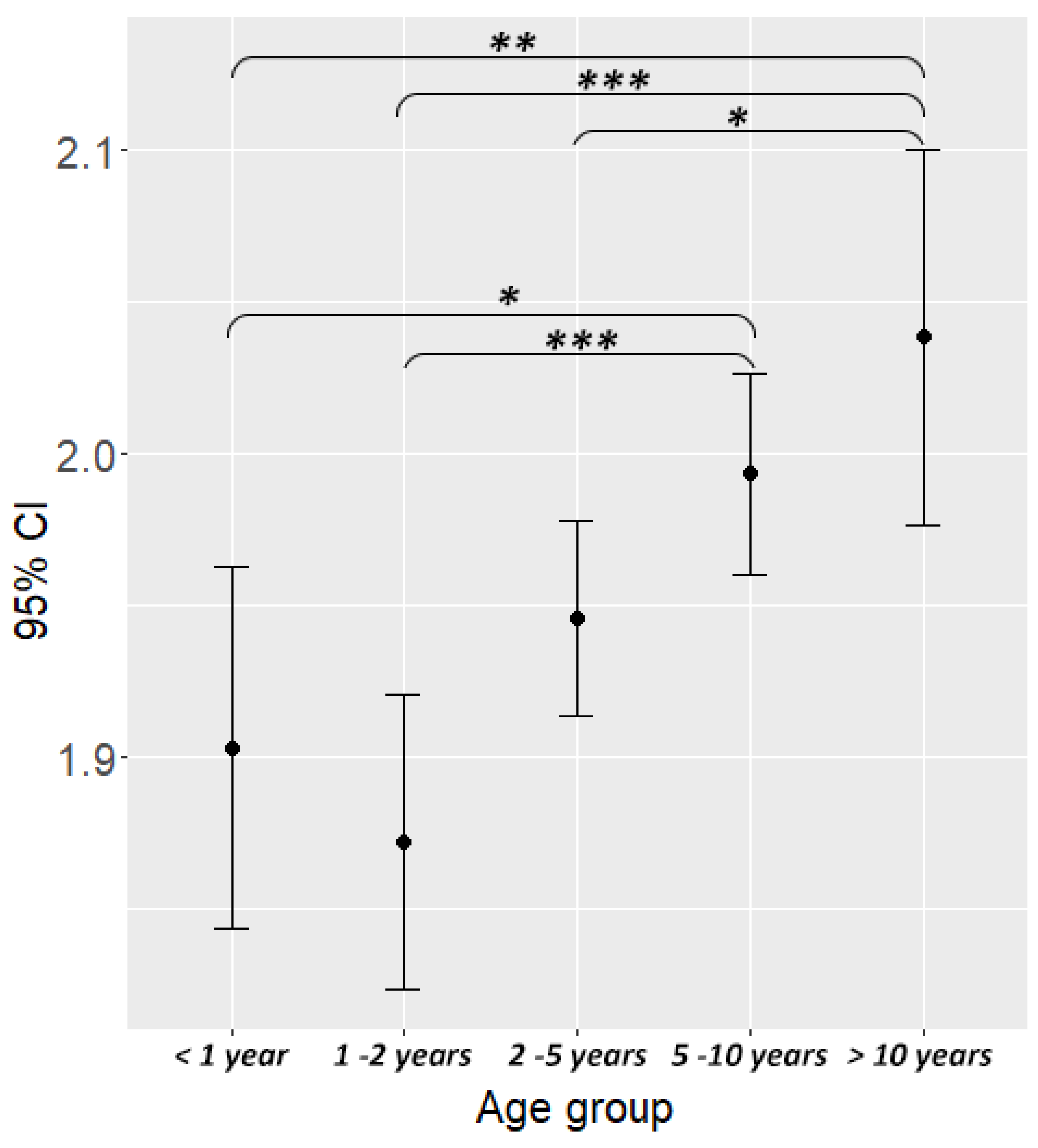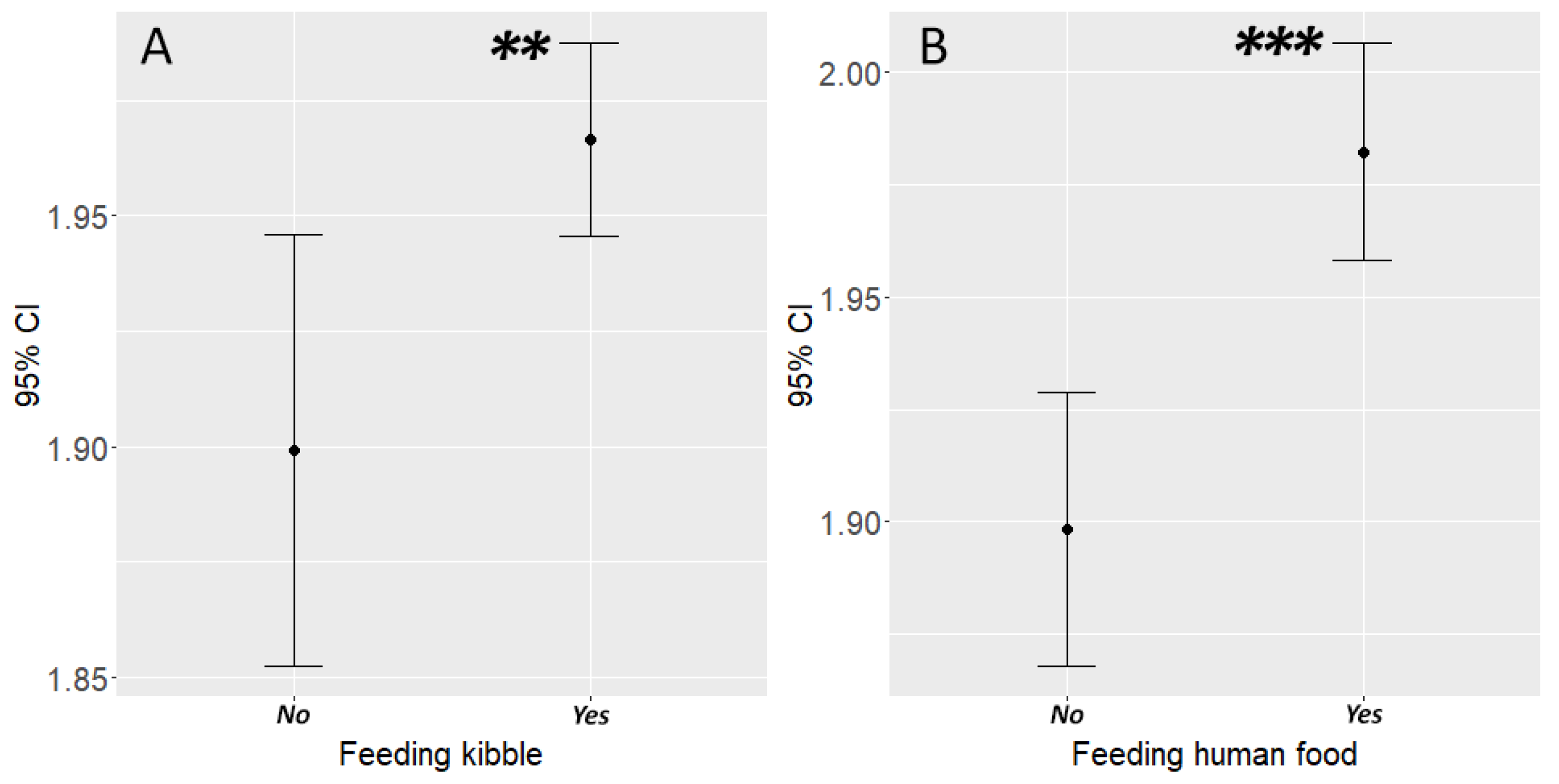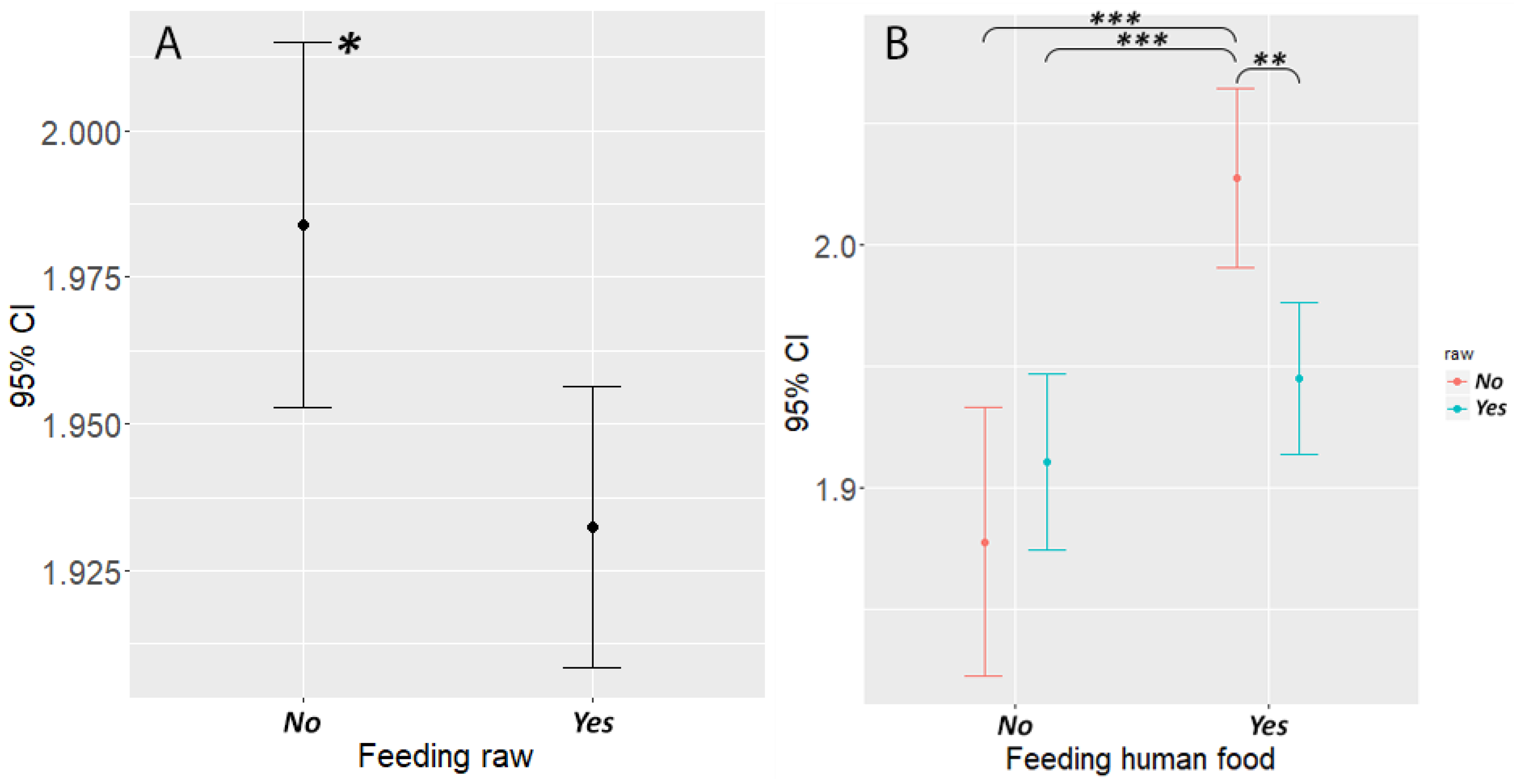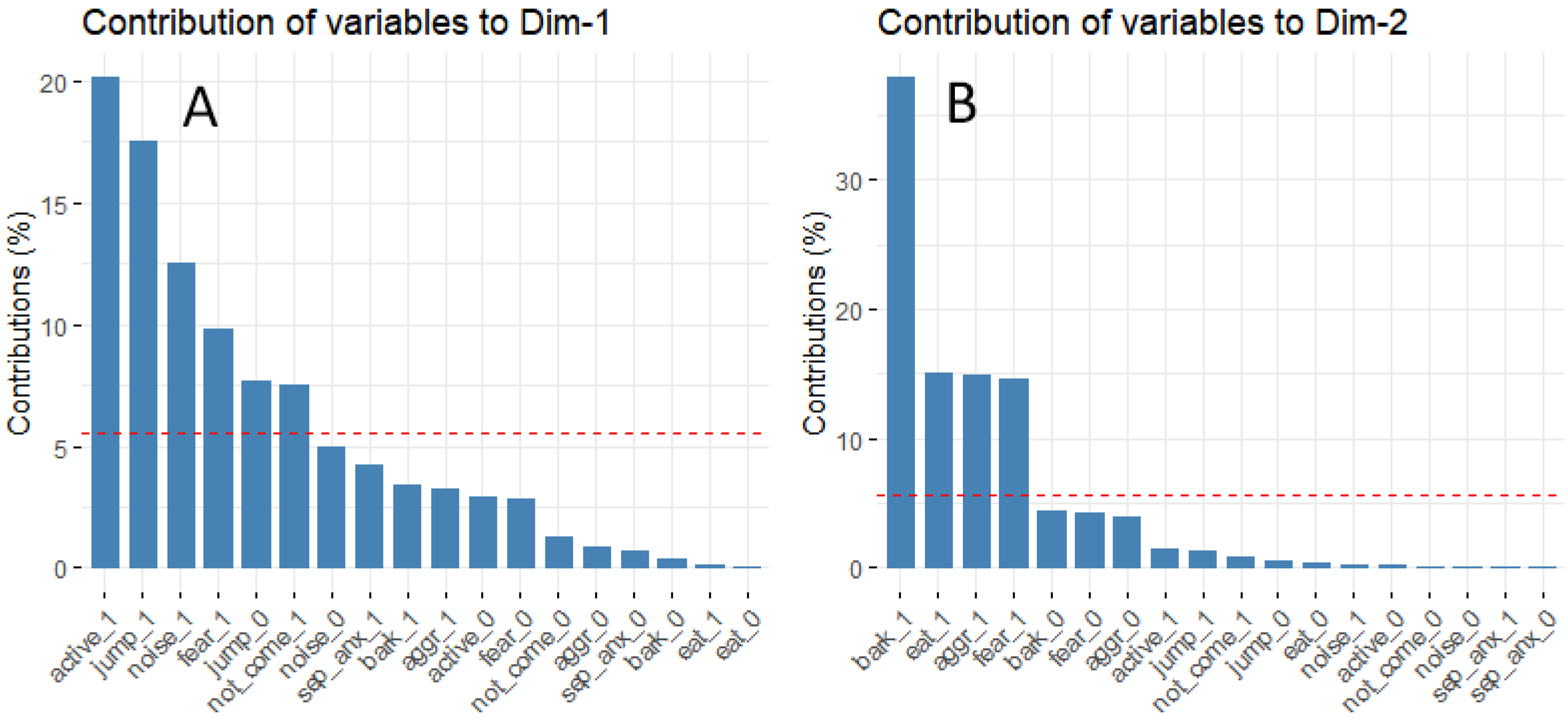Factors Affecting Canine Obesity Seem to Be Independent of the Economic Status of the Country—A Survey on Hungarian Companion Dogs
Simple Summary
Abstract
1. Introduction
2. Materials and Methods
2.1. The Survey
2.2. Subjects
2.3. Variables
2.4. Data Analysis
3. Results
4. Discussion
5. Conclusions
Author Contributions
Funding
Acknowledgments
Conflicts of Interest
References
- Coppinger, R.; Coppinger, L.; Beck, A. What Is a Dog? University of Chicago Press: Chicago, IL, USA, 2015. [Google Scholar]
- Letnic, M.; Ritchie, E.G.; Dickman, C.R. Top predators as biodiversity regulators: The dingo Canis lupus dingo as a case study. Biol. Rev. 2012, 87, 390–413. [Google Scholar] [CrossRef] [PubMed]
- Rohlf, V.I.; Bennett, P.C.; Toukhsati, S.; Coleman, G. Why do even committed dog owners fail to comply with some responsible ownership practices? Anthrozoos 2010, 23, 143–155. [Google Scholar] [CrossRef]
- Jégh-Czinege, N.; Faragó, T.; Pongrácz, P. A bark of its own kind–the acoustics of ‘annoying’ dog barks suggests a specific attention-evoking effect for humans. Bioacoustics 2020, 29, 210–225. [Google Scholar] [CrossRef]
- Wierzbowska, I.A.; Hędrzak, M.; Popczyk, B.; Okarma, H.; Crooks, K.R. Predation of wildlife by free-ranging domestic dogs in Polish hunting grounds and potential competition with the grey wolf. Biol. Conserv. 2016, 201, 1–9. [Google Scholar] [CrossRef]
- Kushner, R.F.; Blatner, D.J.; Jewell, D.E.; Rudloff, K. The PPET study: People and pets exercising together. Obesity 2006, 14, 1762–1770. [Google Scholar] [CrossRef]
- Topál, J.; Miklósi, Á.; Gácsi, M.; Dóka, A.; Pongrácz, P.; Kubinyi, E.; Virányi, Z.; Csányi, V. Chapter 3 The Dog as a Model for Understanding Human Social Behavior. Adv. Study Behav. 2009, 39, 71–116. [Google Scholar]
- Kurdek, L.A. Young adults’ attachment to pet dogs: Findings from open-ended methods. Anthrozoos 2009, 22, 359–369. [Google Scholar] [CrossRef]
- Westgarth, C.; Pinchbeck, G.L.; Bradshaw, J.W.; Dawson, S.; Gaskell, R.M.; Christley, R.M. Factors associated with dog ownership and contact with Dogs in a UK community. BMC Vet. Res. 2007, 3, 5. [Google Scholar] [CrossRef]
- Coleman, K.J.; Rosenberg, D.E.; Conway, T.L.; Sallis, J.F.; Saelens, B.E.; Frank, L.D.; Cain, K. Physical activity, weight status, and neighborhood characteristics of dog walkers. Prev. Med. (Balt.) 2008, 47, 309–312. [Google Scholar] [CrossRef]
- Tsai, K.L.; Clark, L.A.; Murphy, K.E. Understanding hereditary diseases using the dog and human as companion model systems. Mamm. Genome 2007, 18, 444–451. [Google Scholar] [CrossRef]
- Turcsán, B.; Range, F.; Virányi, Z.; Miklósi, Á.; Kubinyi, E. Birds of a feather flock together? Perceived personality matching in owner-dog dyads. Appl. Anim. Behav. Sci. 2012, 140, 154–160. [Google Scholar] [CrossRef]
- Topál, J.; Román, V.; Turcsán, B. The dog (Canis familiaris) as a translational model of autism: It is high time we move from promise to reality. Wiley Interdiscip. Rev. Cogn. Sci. 2019, 10, e1495. [Google Scholar] [CrossRef] [PubMed]
- Tvarijonaviciute, A.; Muñoz-Prieto, A.; Martinez-Subiela, S. Obesity in Humans and Dogs: Similarities, Links, Differences. In Pets as Sentinels, Forecasters and Promoters of Human Health; Springer: Cham, Switzerland, 2020; pp. 143–172. [Google Scholar]
- Pogány, Á.; Torda, O.; Marinelli, L.; Lenkei, R.; Junó, V.; Pongrácz, P. The behaviour of overweight dogs shows similarity with personality traits of overweight humans. R. Soc. Open Sci. 2018, 5, 172398. [Google Scholar] [CrossRef]
- Ravussin, E.; Ryan, D.H. Three New Perspectives on the Perfect Storm: What’s Behind the Obesity Epidemic? Obesity 2018, 26, 9–10. [Google Scholar] [CrossRef] [PubMed]
- Mankowska, M.; Stachowiak, M.; Graczyk, A.; Ciazynska, P.; Gogulski, M.; Nizanski, W.; Switonski, M. Sequence analysis of three canine adipokine genes revealed an association between TNF polymorphisms and obesity in Labrador dogs. Anim. Genet. 2016, 47, 245–249. [Google Scholar] [CrossRef]
- Bannister, S. Possible preventive obesity measures for consideration in Labrador Retrievers Canis lupus familiaris according to veterinarian and owner opinions. Plymouth Stud. Sci. 2013, 6, 1–15. [Google Scholar]
- Lund, E.; Armstrong, P.; Kirk, C.; Klausner, J. Prevalence and risk factors for obesity in adult dogs from private us veterinary practices. Int. J. Appl. Res. Vet. Med. 2006, 4, 177. [Google Scholar]
- Keith, S.W.; Redden, D.T.; Katzmarzyk, P.T.; Boggiano, M.M.; Hanlon, E.C.; Benca, R.M.; Ruden, D.; Pietrobelli, A.; Barger, J.L.; Fontaine, K.R.; et al. Putative contributors to the secular increase in obesity: Exploring the roads less traveled. Int. J. Obes. 2006, 30, 1585–1594. [Google Scholar] [CrossRef]
- Burkholder, W.J.; Bauer, J.E. Foods and techniques for managing obesity in companion animals. J. Am. Vet. Med. Assoc. 1998, 212, 658–662. [Google Scholar] [PubMed]
- Bland, I.M.; Guthrie-Jones, A.; Taylor, R.D.; Hill, J. Dog obesity: Owner attitudes and behaviour. Prev. Vet. Med. 2009, 92, 333–340. [Google Scholar] [CrossRef] [PubMed]
- Muñoz-Prieto, A.; Nielsen, L.R.; Dąbrowski, R.; Bjørnvad, C.R.; Söder, J.; Lamy, E.; Monkeviciene, I.; Ljubić, B.B.; Vasiu, I.; Savic, S.; et al. European dog owner perceptions of obesity and factors associated with human and canine obesity. Sci. Rep. 2018, 8, 133553. [Google Scholar] [CrossRef]
- West, D.B.; York, B. Dietary fat, genetic predisposition, and obesity: Lessons from animal models. Am. J. Clin. Nutr. 1998, 67, 505S–512S. [Google Scholar] [CrossRef] [PubMed]
- Jeusette, I.C.; Lhoest, E.T.; Istasse, L.P.; Diez, M.O. Influence of obesity on plasma lipid and lipoprotein concentrations in dogs. Am. J. Vet. Res. 2005, 66, 81–86. [Google Scholar] [CrossRef] [PubMed]
- McMillan, F.D. Stress-induced and emotional eating in animals: A review of the experimental evidence and implications for companion animal obesity. J. Vet. Behav. Clin. Appl. Res. 2013, 8, 376–385. [Google Scholar] [CrossRef]
- Park, H.J.; Lee, S.E.; Kim, H.B.; Isaacson, R.E.; Seo, K.W.; Song, K.H. Association of Obesity with Serum Leptin, Adiponectin, and Serotonin and Gut Microflora in Beagle Dogs. J. Vet. Intern. Med. 2015, 29, 43–50. [Google Scholar] [CrossRef]
- Rohlf, V.I.; Toukhsati, S.; Coleman, G.J.; Bennett, P.C. Dog obesity: Can dog caregivers’ (Owners’) feeding and exercise intentions and behaviors be predicted from attitudes? J. Appl. Anim. Welf. Sci. 2010, 13, 213–236. [Google Scholar] [CrossRef]
- McGreevy, P.D.; Thomson, P.C.; Pride, C.; Fawcett, A.; Grassi, T.; Jones, B. Prevalence of obesity in dogs examined by Australian veterinary practices and the risk factors involved. Vet. Rec. 2005, 156, 695–702. [Google Scholar] [CrossRef]
- Rowe, E.; Browne, W.; Casey, R.; Gruffydd-Jones, T.; Murray, J. Risk factors identified for owner-reported feline obesity at around one year of age: Dry diet and indoor lifestyle. Prev. Vet. Med. 2015, 121, 273–281. [Google Scholar] [CrossRef]
- Warren, B.S.; Wakshlag, J.J.; Maley, M.; Farrell, T.J.; Struble, A.M.; Panasevich, M.R.; Wells, M.T. Use of pedometers to measure the relationship of dog walking to body condition score in obese and non-obese dogs. Br. J. Nutr. 2011, 106, S85–S89. [Google Scholar] [CrossRef]
- Colliard, L.; Ancel, J.; Benet, J.-J.; Paragon, B.-M.; Blanchard, G. Risk Factors for Obesity in Dogs in France. J. Nutr. 2006, 136, 1951S–1954S. [Google Scholar] [CrossRef]
- Swinburn, B.; Egger, G.; Raza, F. Dissecting obesogenic environments: The development and application of a framework for identifying and prioritizing environmental interventions for obesity. Prev. Med. (Balt.) 1999, 29, 563–570. [Google Scholar] [CrossRef] [PubMed]
- Dempsey, S.; Lyons, S.; Nolan, A. Urban green space and obesity in older adults: Evidence from Ireland. SSM Popul. Health 2018, 4, 206–215. [Google Scholar] [CrossRef] [PubMed]
- World Population Review GDP Ranked by Country. 2020. Available online: http://worldpopulationreview.com/countries/countries-by-gdp/ (accessed on 24 July 2020).
- Baumann, A.E.; Christian, H.E.; Thorpe, R.J.; Macnven, R. International perspectives on the epidemiology of dog walking. In The Health Benefits of Dog Walking for People and Pets: Evidence and Case Studies; Johnson, R., Beck, A.M., McCune, S., Eds.; Purdue University Press: City of West Lafayette, IN, USA, 2011; pp. 25–50. [Google Scholar]
- Rurik, I.; Torzsa, P.; Szidor, J.; Móczár, C.; Iski, G.; Albók, É.; Ungvári, T.; Jancsó, Z.; Sándor, J. A public health threat in Hungary: Obesity, 2013. BMC Public Health 2014, 14, 798. [Google Scholar] [CrossRef] [PubMed]
- Acs, Z.J.; O’Gorman, C.; Szerb, L.; Terjesen, S. Could the Irish miracle be repeated in Hungary? Small Bus. Econ. 2007, 28, 123–142. [Google Scholar] [CrossRef]
- Wan, M.; Kubinyi, E.; Miklósi, Á.; Champagne, F. A cross-cultural comparison of reports by German Shepherd owners in Hungary and the United States of America. Appl. Anim. Behav. Sci. 2009, 121, 206–213. [Google Scholar] [CrossRef]
- German, A.J. The Growing Problem of Obesity in Dogs and Cats. J. Nutr. 2006, 136, 1940S–1946S. [Google Scholar] [CrossRef]
- Courcier, E.A.; Thomson, R.M.; Mellor, D.J.; Yam, P.S. An epidemiological study of environmental factors associated with canine obesity. J. Small Anim. Pract. 2010, 51, 362–367. [Google Scholar] [CrossRef]
- Mobbs, O.; Crépin, C.; Thiéry, C.; Golay, A.; Van der Linden, M. Obesity and the four facets of impulsivity. Patient Educ. Couns. 2010, 79, 372–377. [Google Scholar] [CrossRef]
- Selman, C.; Nussey, D.H.; Monaghan, P. Ageing: It’s a dog’s life. Curr. Biol. 2013, 23, R451–R453. [Google Scholar] [CrossRef]
- Cutt, H.; Giles-Corti, B.; Knuiman, M.; Burke, V. Dog ownership, health and physical activity: A critical review of the literature. Health Place 2007, 13, 261–272. [Google Scholar] [CrossRef]
- Morrison, R.; Penpraze, V.; Beber, A.; Reilly, J.J.; Yam, P.S. Associations between obesity and physical activity in dogs: A preliminary investigation. J. Small Anim. Pract. 2013, 54, 570–574. [Google Scholar] [CrossRef] [PubMed]
- Heuberger, R.; Wakshlag, J. The relationship of feeding patterns and obesity in dogs. J. Anim. Physiol. Anim. Nutr. (Berl). 2011, 95, 98–105. [Google Scholar] [CrossRef] [PubMed]
- Wales, A.; Lawes, J.; Davies, R. How to… Advise clients about raw feeding dogs and cats. BSAVA Companion 2019, 8, 10–15. [Google Scholar] [CrossRef]
- Davies, R.H.; Lawes, J.R.; Wales, A.D. Raw diets for dogs and cats: A review, with particular reference to microbiological hazards. J. Small Anim. Pract. 2019, 60, 329–339. [Google Scholar] [CrossRef] [PubMed]
- Dillitzer, N.; Becker, N.; Kienzle, E. Intake of minerals, trace elements and vitamins in bone and raw food rations in adult dogs. Br. J. Nutr. 2011, 106, S53–S56. [Google Scholar] [CrossRef] [PubMed]
- Edney, A.T.; Smith, P.M. Study of obesity in dogs visiting veterinary practices in the United Kingdom. Vet. Rec. 1986, 118, 391–396. [Google Scholar] [CrossRef] [PubMed]
- Robertson, I.D. The association of exercise, diet and other factors with owner-perceived obesity in privately owned dogs from metropolitan Perth, WA. Prev. Vet. Med. 2003, 58, 75–83. [Google Scholar] [CrossRef]
- Mamun, A.A.; O’Callaghan, M.J.; Cramb, S.M.; Najman, J.M.; Williams, G.M.; Bor, W. Childhood behavioral problems predict young adults’ BMI and obesity: Evidence from a birth cohort study. Obesity 2009, 17, 761–766. [Google Scholar] [CrossRef]
- Puder, J.J.; Munsch, S. Psychological correlates of childhood obesity. Int. J. Obes. 2010, 34, S37–S43. [Google Scholar] [CrossRef]





| Name of Variable | Description | Measure |
|---|---|---|
| Demographic Data | ||
| Dog Age | Age of the dog divided into five age groups: below 1 year; 1–2 years; 2–5 years; 5–10 years; above 10 years | 1–5 |
| Place of Keeping | Where does the owner mainly keep his/her dog: inside (in an apartment or house), both outside (garden or kennel) and inside the house; in the garden; in a kennel | 1–4 |
| Dog–Owner Relationship | ||
| Dog Role | What is the dog’s role in the owner’s life: like a child or family member; friend, playmate or colleague; working or domestic animal | 1–3 |
| Active Time | The amount of time the owner actively spends with the dog in a day (training, playing, walking, etc.): more than 3 h; 1–3 h; less than 1 h; none | 1–4 |
| Behavioral Problems | ||
| Separation anxiety | 0; 1 | |
| Aggression (towards people or other dogs) | 0; 1 | |
| Food-related problems (stealing food, devouring food) | 0; 1 | |
| Fearful | 0; 1 | |
| Jumping on people | 0; 1 | |
| Noise sensitivity | 0; 1 | |
| Excessive barking | 0; 1 | |
| Hyperactivity | 0; 1 | |
| Not coming back when called | 0; 1 | |
| Reward | ||
| Reward Type | If the owner ever uses food as a reward during training | 0; 1 |
| Feeding | ||
| Commercial | If the owner ever feeds commercial dog food to the dog | 0; 1 |
| Human Food | If the owner ever feeds human food to the dog | 0; 1 |
| Home-made | If the owner ever cooks specifically for the dog | 0; 1 |
| Raw Diet | If the owner ever feeds a raw diet to the dog | 0; 1 |
| Main Food Type | The main type of food the owner gives to the dog: only commercial; never commercial; both commercial and other | 1–3 |
| Activity | ||
| Physical Activity | Level of physical activity: none; hobby; sport | 1–3 |
| Body Condition | ||
|---|---|---|
| Palpation | The dog’s condition according to the three-level scoring system. Underweight: It is easy to touch and see the contour of the ribs, the lumbar vertebrae, and the pelvic bones. The muscular mass is reduced and the body fat is almost undetectable under the skin. The dog has a markedly visible waist section. Normal: The ribs are easy to touch; they are covered by a thin layer of fat under the skin. The waist section is well visible. Overweight: It is difficult, or impossible to locate the ribs, because of the thick layer of fat under the skin. The waist section is almost undetectable. | 1–3 |
| Owner Opinion | The owner’s holistic opinion on the dog’s body condition: overweight; not overweight. | 1–2 |
| Veterinarian Opinion | The veterinarian’s opinion about the dog’s body condition: underweight; normal; overweight. | 1–3 |
| Condition According to the Three-Level Scoring System | Condition According to the Owner | Condition According to the Veterinarian | ||
|---|---|---|---|---|
| Condition According to the Three-level Scoring System | Pearson correlation | 1 | 0.364 | 0.296 |
| Sig. (2–tailed) | <0.0001 | <0.0001 | ||
| Condition According to the Owner | Pearson correlation | 1 | 0.407 | |
| p (2–tailed) | <0.0001 | |||
| Condition According to the Veterinarian | Pearson correlation | 1 | ||
| p (2–tailed) |
| Kibble | Raw | N |
|---|---|---|
| No | No | 23 |
| No | Yes | 235 |
| Yes | No | 596 |
| Yes | Yes | 594 |
| Human food | Raw | N |
| No | No | 180 |
| No | Yes | 302 |
| Yes | No | 439 |
| Yes | Yes | 527 |
| Non-commercial | Raw | N |
| No | No | 263 |
| No | Yes | 335 |
| Yes | No | 356 |
| Yes | Yes | 494 |
© 2020 by the authors. Licensee MDPI, Basel, Switzerland. This article is an open access article distributed under the terms and conditions of the Creative Commons Attribution (CC BY) license (http://creativecommons.org/licenses/by/4.0/).
Share and Cite
Orsolya Julianna, T.; Kata, V.; Vanda Katalin, J.; Péter, P. Factors Affecting Canine Obesity Seem to Be Independent of the Economic Status of the Country—A Survey on Hungarian Companion Dogs. Animals 2020, 10, 1267. https://doi.org/10.3390/ani10081267
Orsolya Julianna T, Kata V, Vanda Katalin J, Péter P. Factors Affecting Canine Obesity Seem to Be Independent of the Economic Status of the Country—A Survey on Hungarian Companion Dogs. Animals. 2020; 10(8):1267. https://doi.org/10.3390/ani10081267
Chicago/Turabian StyleOrsolya Julianna, Torda, Vékony Kata, Junó Vanda Katalin, and Pongrácz Péter. 2020. "Factors Affecting Canine Obesity Seem to Be Independent of the Economic Status of the Country—A Survey on Hungarian Companion Dogs" Animals 10, no. 8: 1267. https://doi.org/10.3390/ani10081267
APA StyleOrsolya Julianna, T., Kata, V., Vanda Katalin, J., & Péter, P. (2020). Factors Affecting Canine Obesity Seem to Be Independent of the Economic Status of the Country—A Survey on Hungarian Companion Dogs. Animals, 10(8), 1267. https://doi.org/10.3390/ani10081267






